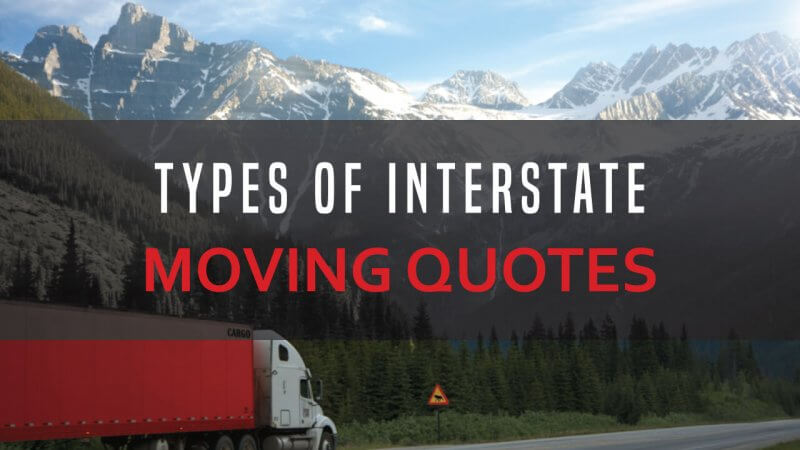Interstate Moving Quotes
The three moving quote options offered by long distance moving companies include binding, binding not-to-exceed, and non-binding. The type of moving quote you will determine your cost and overall moving experience. Never agree to a quote or sign a contract without understanding what you are agreeing to.
Binding Quotes
A binding quote means:
1. The quote is given at the beginning of the move, before the process begins, based on the approximate weight of your belongings.
2. The quote cannot be changed during the move, and the customer will pay exactly what they agreed to pay upfront (even if the items weigh less than then estimated amount).
Cons
- If items weigh less than estimated, the customer still must pay the price quoted from the start.
- The client must whittle down all possessions before getting a moving quote, so their movers can provide an accurate estimate.
- The customer cannot add additional items on moving day, so make sure all items are present when the quote is given.
Pros
- You always pay exactly what you agree to. Once you find a price you are comfortable with, you plan to pay it and move on with your life.
- You can shop around for moving companies. You can compare binding quotes directly, and accurately select the best moving company for you.
Non-Binding Quotes
A non-binding estimate is only an approximate estimate. It can change, which is what makes it non-binding.
Cons
- A non-binding quote means you could end up spending far more than anticipated on your move if the estimator isn’t accurate. A company who provides a non-binding quote will provide you with an estimate based on the anticipated weight of your belongings. If the final weight exceeds your original estimate, you usually have about a month to pay the difference between the first quote and the actual price.
- This type of quote makes budgeting difficult and favors the moving company.
Pros
- A non-binding estimate can be a great starting point for understanding moving costs during the initial research phase. Per FMCSA regulations, a mover may not charge a customer more than 10% over the original estimate.
- Another upside to a non-binding quote is that it may be motivating for people who are trying to get rid of as much as possible. The more you can sell or donate, the less your move will cost in the end.
Binding-Not-to-Exceed Quote
Binding not-to-exceed is a very popular type of long-distance estimate. It is the most customer-friendly type of quote. With a binding-not-to-exceed estimate:
1. You will be given a quote upfront based on the approximate weight of your belongings.
2. If the shipment weighs more than the quote given, you will not pay a penny more than what you agreed to. You are only responsible for the amount you were originally quoted.
3. If your belongings weigh less than originally estimated, your cost will decrease. The customer is only responsible for the cost of the actual weight of their belongings.
Cons
- There really aren’t any drawbacks to this type of quote! Just make sure you provide the moving company with an accurate inventory. If they discover you added items after the quote was provided, it could nullify the contract.
Pros
- Most favorable quote option for consumers since you won’t have to pay more if the shipment weighs more.
- There’s still incentive to get rid of things before the move, since a lower shipping weight will translate to cost savings.
We hope this explanation of interstate moving quotes makes your life a little easier and reduces your moving costs.
How to Get an Accurate Moving Quote
You want your quote to be as precise as possible, so you can keep on track with your moving budget.
So how can you secure an accurate moving quote? Request an in-home estimate! For a long distance move, moving companies are required by law to send an estimator to your home to take an inventory of your items and provide a written quote based on an estimate of the final shipping weight.
Here are some ways you can prepare to ensure a more accurate final estimate.
- Declutter first: You should: 1) have donated, sold, or thrown away everything that you won’t be moving with you and 2) have decided exactly what will be coming with you and what will stay behind. Label these items accordingly. Check out the moving company’s website to learn more about what they offer before they arrive.
- Be there: One of the most important things you can do is be there with your in-home estimator. You can add a verbal component to his visual inspection, by explaining the details and intricacies of your relocation. Prepare some questions if you have any. Be sure to show the estimator every room, including the garage and attic.
- Get plenty of quotes: Determine which moving services you want, then schedule two or three in-home estimates with different moving companies. This way, you can get three different quotes for the same services and compare them side-by-side. Make sure to always start by checking a company’s licensing information. Don’t waste your time getting estimates from unlicensed movers.
Getting your in-home estimate done may seem like quite a task, but it will help you prepare for the changes ahead. An accurate estimate will leave you feeling organized and prepared for your interstate relocation. To find licensed interstate moving companies serving your area, click the Get Quote button now!

